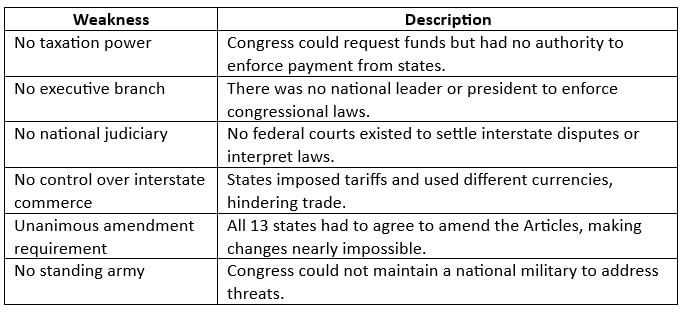Challenges of the Articles of Confederation Chapter Notes | AP U.S Government and Politics - Grade 12 PDF Download
Introduction
The Articles of Confederation, enacted in 1777 during the Revolutionary War and fully ratified by 1781, formed the United States’ initial constitution. Crafted to unify the newly sovereign states while steering clear of tyrannical rule, the Articles established a feeble national government, vesting substantial authority in the states. However, the shortcomings of this framework soon surfaced. The central government lacked the ability to levy taxes, regulate trade between states, or establish an executive or judicial branch to enforce laws or settle disputes. These deficiencies triggered economic turmoil, political volatility, and an incapacity to address national emergencies, paving the way for the 1787 Constitutional Convention.
Core Weaknesses of the Articles of Confederation
The Articles embodied the colonists’ apprehension of concentrated authority, but the resulting system was too frail to govern efficiently. Several critical flaws highlight why the Articles faltered:

The Articles prioritized state autonomy over national cohesion, creating a delicate governmental structure. The following five weaknesses, underscored by historical events and legal obstacles, were instrumental in necessitating the creation of the U.S. Constitution.
1. Lack of Centralized Military Power to Address Shays’ Rebellion
Congress lacked the power to sustain a standing army or compel states to provide troops, leaving the national government defenseless during internal conflicts.
- Shays’ Rebellion (1786–87) exposed this vulnerability. Massachusetts farmers, led by Daniel Shays, revolted against debt foreclosures and heavy taxation, but the federal government could not muster a response.
- The uprising was quelled by state militias, highlighting the central government’s inability to maintain order.
Why it matters: Without military authority, the government could not ensure citizen safety or uphold laws during crises.
2. Lack of an Executive Branch to Enforce Laws, Including Taxation
The Articles omitted an executive branch, leaving no centralized figure—like a president—to execute or enforce congressional legislation.
- Congress could request taxes or compliance, but states frequently disregarded these calls, resulting in chronic underfunding and governmental inefficacy.
Why it matters: Laws lacking enforcement are ineffective; the government could pass resolutions but had no means to implement them.
3. Lack of a National Court System
The Articles did not establish a national judiciary to interpret laws or mediate interstate conflicts.
- Disputes between states, such as territorial or trade disagreements, lacked an impartial arbiter.
- No institution existed to ensure uniform application of laws nationwide.
Why it matters: Without a judicial system, legal disputes festered, and states operated under inconsistent interpretations of law.
4. Lack of Power to Regulate Interstate Commerce
Congress was powerless to oversee trade among states or with foreign entities.
- States levied tariffs on each other, maintained separate currencies, and followed divergent trade policies, hampering economic unity.
- These practices stifled interstate commerce and national economic growth, fostering inefficiency and confusion.
Why it matters: A disjointed economy undermined national cohesion and hindered the development of a unified American market.
5. Lack of the Exclusive Power to Coin Money
Both the national government and states could issue currency, leading to economic instability.
- States printed their own money, often without sufficient backing, causing widespread inflation.
- Varying currency values complicated cross-state commerce.
Why it matters: Competing currencies and inflation eroded public trust and disrupted domestic and international trade.
Shays’ Rebellion: A Catalyst for Change
From 1786 to 1787, Shays’ Rebellion in Massachusetts exposed the Articles’ critical flaws. Led by Daniel Shays, a Revolutionary War veteran, farmers protested against heavy taxes, foreclosures, and economic hardship.
Causes:
- Post-war economic depression
- High state taxes
- Lack of a stable national currency
- Debtors’ prisons
What Happened:
- The Massachusetts government struggled to respond due to the lack of federal military support. State militias eventually suppressed the rebellion, but the episode alarmed national leaders.
Why it matters: The federal government’s inability to address the uprising highlighted the urgent need for a stronger national framework.
From Articles to Constitution: A Shift in Government Philosophy
The Articles’ deficiencies spurred leaders like George Washington, Alexander Hamilton, and James Madison to advocate for a Constitutional Convention. Convened in Philadelphia in 1787, the convention sought to replace, not amend, the Articles.
The new U.S. Constitution established:
- A robust central government empowered to tax, regulate trade, and maintain a military.
- An executive branch, led by a president, to enforce laws.
- A federal judiciary to interpret laws and resolve disputes.
- A more practical amendment process.
- A bicameral legislature balancing state and population representation.
This framework rectified nearly all the Articles’ shortcomings, laying a durable foundation for American governance.
Key Incidents and Challenges Under the Articles

Key Terms
- Articles of Confederation: The U.S.’s first constitution, emphasizing state sovereignty and a weak central government.
- Unicameral Legislature: The sole national institution under the Articles.
- Commerce Clause: Missing from the Articles, later included in the Constitution to regulate trade.
- Shays’ Rebellion: A 1786–87 uprising that exposed federal weaknesses.
- Constitutional Convention (1787): The meeting that replaced the Articles with a stronger federal framework.
- Articles of Confederation: The initial governing document of the United States, ratified in 1781, creating a loose confederation of states with a weak central authority. It prioritized state sovereignty but proved inadequate for addressing national challenges.
- No Executive or Judicial Branches: Refers to the absence of a centralized executive or judiciary under the Articles of Confederation (1781–1789). Without a national leader to enforce laws or courts to interpret them, governance faltered, exacerbating federal weaknesses.
- No Control Over Commerce: The federal government’s inability under the Articles to regulate interstate or foreign trade, leading to economic discord as states imposed tariffs and pursued conflicting policies, undermining national growth.
- No Taxation Powers: The central government’s lack of authority under the Articles to directly tax individuals or states, resulting in financial instability and governance challenges due to insufficient revenue.
- Requirement of Unanimity for Changes: The mandate that amendments to the Articles required all 13 states’ approval, making reforms nearly impossible and limiting the government’s adaptability.
- Shays’ Rebellion: An armed uprising in 1786–1787 led by Daniel Shays in Massachusetts, protesting economic injustices. It exposed the Articles’ weaknesses, particularly in handling unrest, spurring calls for a stronger national government.
- US Constitution: The supreme law of the United States, establishing the government’s framework, powers, and citizen rights. It addressed the Articles’ shortcomings, creating a robust federal system.
- Weak Central Government: A system where national authority lacks the power to enforce laws, regulate trade, or maintain order, as seen under the Articles, highlighting its governance limitations.
FAQs on Challenges of the Articles of Confederation Chapter Notes - AP U.S Government and Politics - Grade 12
| 1. What were the core weaknesses of the Articles of Confederation? |  |
| 2. How did Shays’ Rebellion highlight the challenges of the Articles of Confederation? |  |
| 3. What were the key challenges faced by the U.S. under the Articles of Confederation? |  |
| 4. How did the transition from the Articles of Confederation to the Constitution address these challenges? |  |
| 5. Why is understanding the challenges of the Articles of Confederation important for understanding American history? |  |




















